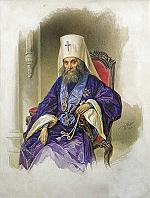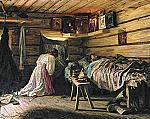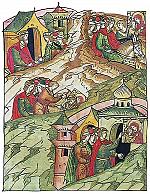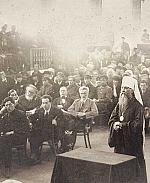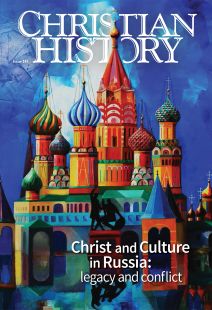High and holy days
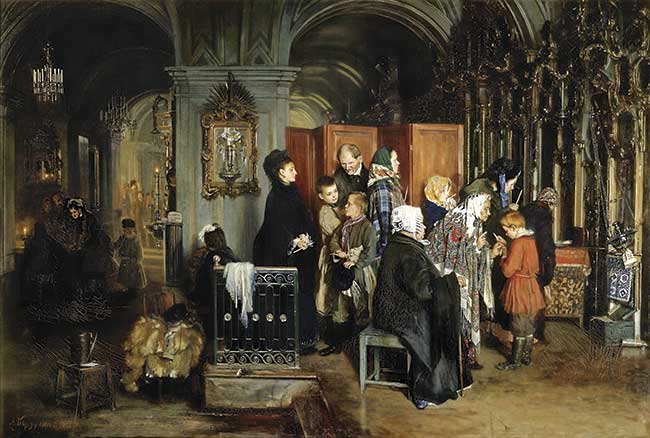
[above: Alexei Korzukhin, Before Confession, 1877. Oil on canvas—Tretyakov Gallery / Public domain, Wikimedia ]
Lying down to pray in front of a cross adorned with sweet-smelling flowers; processing through the snow and carrying back holy water; kissing at the Easter midnight service amid the ringing of bells and singing “Christ is risen”; awaiting the descent of the Holy Spirit with grass strewn on the floor and tree branches all around; and, if you were a small child on Palm Sunday, whacking your friends with pussy willow branches—Orthodox worship was an embodied activity.
Before 1917 liturgy in the empire linked individual believers with their family, school, or place of work; with the parish community; with the tsar and his family; with departed ancestors and saints; and with the larger Orthodox world. How they dressed; the words they heard and spoke or sang; the way they moved through liturgical spaces; what they touched, smelled, and tasted; what they carried with them and shared with others or brought back from religious ceremonies—all this formed the way Orthodox Christians throughout the empire experienced shared religious life.
Ancient domes
To be sure regional variations existed. The Russian heartland with its ancient golden-domed churches offered a different worship context than solitary wooden churches and hermitages in the north or the newly Christianized regions of Siberia and the far east. Orthodox Christian inhabitants of present-day Ukraine and Belarus had spent centuries living next to Roman Catholics, Greek Catholics, Jews, and Protestants in the Polish-Lithuanian Commonwealth. This meant persecution and second-class status because of their Orthodox faith—but it also meant absorbing some practices from their neighbors and being forced to ponder, defend, and articulate their faith in ways very unlike those who had lived for centuries under the reign of an Orthodox tsar.
Those who lived in the Caucasus, Crimea, and central Asia, including the Georgians and the Armenians, encountered (and sometimes had been converted from) Islam—but also came in contact with more ancient Christian traditions. These differences could affect such things as how one fasted, where one traveled on pilgrimage, or how intensively one prepared for the sacraments of confession and Communion.
Still the church calendar and the liturgy provided enough of a shared framework that Orthodox Christians could travel throughout the diverse empire, enter any church or join any religious procession, and feel at home.
Twelve great feasts formed the core and backbone of the liturgical calendar. Commemorating key events in the lives of Jesus Christ and the mother of God, they punctuated nearly every month. The church counted its new year from September 1, although Peter the Great had introduced the celebration of the secular New Year on January 1, mandating the fir trees, presents, and fireworks he had observed on his travels to London and Amsterdam.
In September feast days included the birth of the Virgin Mary on September 8 and the Exaltation of the Holy Cross on September 14. The latter was celebrated with particular solemnity. In every parish church, flowers or sweet-smelling herbs adorned the cross; people would prostrate themselves before it as it was brought out solemnly at the end of the All-Night Vigil. (Every major feast had an eve, and sometimes the evening service could be more splendid than the one on the feast’s morning.)
Sight of the first star
November 21 was the Entry of the Mother of God into the Temple. At the end of the Nativity Fast (roughly comparable to Advent), Christmas Day on December 25 set off a 12-day cycle of celebration and merriment that reached its climax on January 6, the day of Jesus’s baptism and his becoming manifest in the world—hence the name Theophany (Bogoiavlenie) rather than Epiphany. Although in Western tradition Christmas Day had become the focus of these celebrations, in Russia (and in most of the Orthodox world) the emphasis was on the 12 days as a cycle, with the eves of both Christmas and Theophany (Twelfth Night) sharing unique liturgical elements as well as being days of strict fasting.
To evoke the experience of humanity awaiting the Savior—and of the shepherds abiding in the fields—Russian Orthodox Christians were not supposed to eat until the sighting of the first star on Theophany. Indeed in Russia (and in most of the Orthodox world), Theophany rather than Christmas was arguably the grandest liturgical celebration of the 12 days. At its high point, worshipers processed from the church through the snow to some source of water (a river, a lake) to bless it and to bring home the now-holy water.
On February 2, the Presentation of Christ in the Temple, people would bring home candles blessed in church. March 25, the Annunciation, celebrated the day Gabriel spoke to the Virgin Mary (Luke 1:26–38). Orthodox believers venerated it so highly as a holy day that they forbade any work. According to a folk saying, “the bird does not weave its nest, and the maiden does not braid her hair.”
Between the Presentation and the Annunciation, Russian Orthodox Christians began to prepare liturgically for the greatest feast of all—Easter (Pascha)—through experiencing Great Lent. Russian Orthodox Christians were required to go to confession and Communion (govienie) at least once a year, and almost all of them did so in these weeks.
As in Western churches, the church carefully designed the Lenten season to encourage a mood of repentance. The liturgical structure of penance looked different from the West, however. Four weeks before Lent actually began, for example, the Sunday of the Publican and the Pharisee emphasized that one should not repent showily or be complacent about one’s prowess in prayer, tithing, and fasting, but rather maintain a mood of constant compunction (Luke 18:9–14).
The next week’s parable suggested that each person is the Prodigal Son, who had squandered his inheritance in riotous living and crawled back in shame to his father; God, the loving Father, gladly welcomed back his broken child (Luke 15:11–32). The Sunday of the Last Judgment then showed Christians what would happen to those who had not fed the hungry, taken in the stranger, clothed the naked, nursed the sick, or visited the prisoner: they, like the goats, would be sent to everlasting punishment (Matt. 25:31–46).
This reminder to focus on the needs of others became an important corrective to the popular association of Lent with abstinence from meat, dairy, and sexual relations. It also emphasized that one could only repent in this life and therefore should take care to confess sins while still able.
Clean, shiny hair
Matthew 6:14–21, read on the last Sunday before Lent, sums up the goals of repentance; “If you forgive others their trespasses, your heavenly Father will also forgive you, but if you do not forgive others their trespasses, neither will your Father forgive yours.” It reminded hearers not to fast “like the hypocrites,” looking doleful and haggard—but with a washed face and a clean, shiny head of hair. As the ritual closing of Forgiveness Sunday Vespers, each person had to ask forgiveness of, and themselves forgive, every other person present with a full bodily prostration.
Lent began liturgically not on Ash Wednesday (not observed in Russia), but during Forgiveness Sunday Vespers. Fasting from dairy and fish officially started after midnight, although priests bemoaned carousing and devouring pancakes (blini) with caviar and sour cream beforehand. During Vespers the liturgy signaled transition into Lent. Priests changed their vestments to black, worshipers began singing litanies in a minor key, and all performed prostrations during the Prayer of St. Ephraim the Syrian. This prayer would be repeated numerous times at every subsequent Lenten service, lodging itself firmly in Russian Orthodox consciousness.
The first week of Lent itself prepared and transformed worshipers. The Great Canon of St. Andrew of Crete, read in church on the first four nights, draws extensively on both the Old and New Testaments to inspire Orthodox Christians to repentance. Read again at the fifth week of Lent, it offered a chance to think of how far—or how little—one had come.
The two occasions after it was read, whether the first Saturday of Great Lent (the feast of St. Theodore of Tyro) or the fifth (St. Mary of Egypt), were favorite choices for govienie. Other popular occasions for these rites included the third week of Great Lent, when the flower-decorated cross remained in the middle of the church for a week to remind people of the redeeming Crucifixion of Jesus and the point of their Lenten penance.
The Life of St. Mary of Egypt, read in its entirety on the evening of the fifth Wednesday of Great Lent, provided the template of a great sinner—a sex addict—who had attained holiness through 47 years of solitary repentance and asceticism in the desert. The next evening the Laudation of the Mother of God included the communal singing of the beloved Akathist hymn; this made that week another popular time for govienie.
These Lenten rites reminded Russian souls that they undertook the annual journey from old to new, from spiritual stupor and death to spiritual rebirth, together with the rest of humanity. In daily life most Orthodox Christians in imperial Russia experienced govienie with others in their family, their parish, their school, their workplace, or their regiment.
Lazarus Saturday and Palm Sunday marked a welcome pause between the “bright sadness” of Lent proper and the dark mourning of Holy Week. Reflecting the festal bright spot, fasting standards relaxed to allow caviar (Lazarus Saturday) and fish (Palm Sunday), and vestments shifted to green (the same color used at Pentecost) as a symbol of new life. Children of all ages enjoyed getting pussy willows in lieu of palms—and, in some regions, thwacking one another with them while reciting verses anticipating Easter. And then came Passion Week with its black vestments.
As in many Western traditions, Holy Thursday, the last meal Jesus Christ shared with his disciples, was the most popular day for Russians to partake of govienie. From Thursday evening on, Orthodox Christians focused on Christ’s betrayal, suffering, and death. Thursday evening’s Passion Gospels, taking out the Shroud on Great Friday afternoon, and Christ’s symbolic burial on Matins (the morning service) of Great and Holy Saturday, were the most somber and best-attended services of the year.
A vision of dry bones
With the reading of Ezekiel’s vision of dry bones coming to life and the triumphant words, “Let God arise and His enemies be scattered,” Great and Holy Saturday signaled the end of darkness, a theme reinforced by the changing of the vestments from black to white. At midnight came Easter, “the feast of feasts”: an explosion of joy, bell-ringing, kissing one’s neighbor three times, chorusing “Christ is risen!” over and over, and baskets with eggs and butter and sausage and ham to devour after the midnight services.
Ascension, the next major feast, was followed by Pentecost. On Pentecost the church became a sea of green, decorated with grass strewn over the entire floor and tree branches (sometimes entire trees) tied to the iconostases (an iconostasis is a screen separating the sanctuary from the altar area) and columns. The entire congregation solemnly sang the prayer invoking the Holy Spirit with which they customarily began all prayer, but which they had not heard for 50 days.
Kneeling and prostration, both of which had been banned during the Paschal (Easter) period, came back as the priest read prayers to the Holy Spirit. Then began another movable period of fasting before the feast day of the apostles Peter and Paul (June 29) and a shorter fast before the August 15 Dormition (Assumption) of the Mother of God, punctuated with the Transfiguration on August 6—beloved in part because it included blessing the first fruits of the harvest.
These major holidays were joined by many others, including commemoration of departed ancestors on several Saturdays throughout the year; John the Baptist’s nativity (June 24) and beheading (August 29); the Protecting Veil of Mary (October 1)—a holiday especially venerated by Cossack troops—and feast days of especially beloved saints (Nicholas, George, Demetrius) and Marian icons (such as the Vladimir, the Smolensk, and the Kazan).
Thus, even as it shared many of the same holidays and rites with both Eastern and Western Christians, as the largest Orthodox polity in the world, the Russian Empire had developed a particularly elaborate liturgical tradition—one that would take the Bolsheviks decades to uproot. CH
By Nadieszda Kizenko
[Christian History originally published this article in Christian History Issue #146 in 2023]
Nadieszda Kizenko is professor of history and religious studies program director at the University at Albany and the author of A Prodigal Saint: Father John of Kronstadt and Good for the Souls: A History of Confession in the Russian Empire.Next articles
Christian History TImeline: Christ and culture in Russia
Selected events from this issue and their context. (Underlined items represent the rise to power of some major political leaders.)
the editorsSupport us
Christian History Institute (CHI) is a non-profit Pennsylvania corporation founded in 1982. Your donations support the continuation of this ministry
Donate



